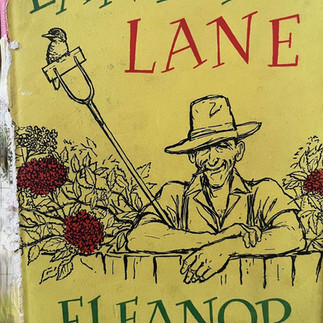FEATURE - Throw it Down in the Lantana
- Ronalyn

- Jun 22, 2024
- 3 min read
by Gillie Warren
Reminiscing on her days with the Montville History Group, Gille Warren recalls learning about an interesting local figure, esteemed Australian writer, Eleanor Dark.
There is a very venerable Remington ‘tippety-tappety-clang’ typewriter in a cupboard at Razorback House behind Montville State School. It belonged to Jim Walker, but he lent it to a neighbour in Mill Hill Road when she lived there in the 1950s.
That typewriter produced the letters and words and chapters of a wonderful book called Lantana Lane, and the fingers that typed belonged to Eleanor Dark, one of Australia’s most distinguished writers.
Eleanor Dark was born in Sydney in 1901, daughter of Dowell O’Reilly, poet, schoolteacher and, for a short time, Labour politician. Dowell introduced the first bill for Women’s Suffrage into the New South Wales Legislative Assembly. Certainly he encouraged his daughter’s education and pathway to a literary career.
It is obvious that Eleanor was intellectually gifted; she was reading at the age of three, and by seven was writing stories and verses. Her first story was published when she was nineteen.
Eleanor O’Reilly married Dr Eric Dark in 1922, and they lived at Katoomba, in the Blue Mountains west of Sydney, where Dr Dark had a medical practice. They had two sons, and Eleanor pursued her writing career; by 1936 she had published three books, two of them winning Gold Medals from the Australian Literature Society.
She was also a member of the Fellowship of Australian Writers along with other women literary greats, including our own Emily Palmer Bulcock, first teacher at the Razorback School.
Eleanor was to write a total of ten books including her famous trilogy based on the early history of Australian settlement, comprising The Timeless Land, Storm of Time and No Barrier. In 1977 Eleanor was awarded the Order of Australia for services to Australian literature. The trilogy was made into an ABC series in 1979 called The Timeless Land.
The Darks designed and had built a lovely home, “Veruna”, in Katoomba, but they also had a special folly, a summer home in a cave, which they had excavated themselves. They were serious bushwalkers and mappers, and Eric Dark knew the bush of the Blue Mountains as though it was his backyard.
But there was another, sombre, purpose to the cave; Dr. Dark fully expected to die fighting a guerrilla war with the Japanese, and the cave was to be a last citadel.
The Darks were overtly opposed to what they saw as an increasing fascism in the world, and this perceived criticism of Australian society very quickly brought accusations of communism. They were so harassed that in the early fifties they left Katoomba, the medical practice and the typewriter behind, and moved to Montville.
The Darks spent ten years in Montville, at the farm called “The Macadamerie” in Mill Hill Road, first established by the Bowser family. They grew citrus and pineapples, lived quietly, and left the establishment alone.
But one day Eleanor, in the middle of a game of bridge with Jim and Gwen Walker at their home Braemar at 116 Main Street Montville, must have admitted to the longing to put a new story on paper, and begged the loan of the Walker’s typewriter.
In 1959 she produced her last book, Lantana Lane, a novel totally different from her previous works; light, gently teasing and observant. You MUST read it. The book is still in most libraries, and there is one copy in the library at the Montville Hall.
To try to précis it would take from your pleasure. Anybody who lived in Montville in the fifties will tell you that Lantana Lane was Mill Hill Road, ‘The Other Road’ was of course the Western Road, and some might even identify a resident or two!
My own copy was re-printed in 1986 and has a marvellous introduction by Helen Garner. She too had to restrain herself from quoting more than a paragraph or two from an early chapter called ‘Gwinny on Meat-day’.
Eleanor and Eric Dark did return to “Veruna”; Eleanor died in 1985, and Eric in 1987. Her legacy to Montville is this affectionate, tolerant “contemplation of an isolated little farming community, round the corner from the world”.
Eleanor and Eric Dark’s home, the Macadamerie (now Mill Hill Manor), is one of the houses featured in the Montville History Group’s upcoming Book 10 Montville Buildings in the Montville Stories Series.
Recent Posts
See AllSet in one of the most iconic parts of the Sunshine Coast Hinterland and a stone's throw from the beloved Kondalilla Falls, Kondalilla...
Since its beginnings in 1986, RangeCare has relied on the generosity of local volunteers to support the organisation in its efforts to...


























Comments